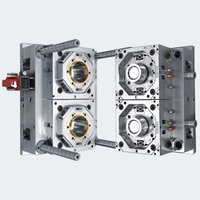Mould Steel For Thin-wall Plastic Pail Mould
-
The prevalence of take-out packaging has made the demand for one-time packaging lunch boxes great, and the packaging box Plastic Pail Mould market has also caught up with the development trend. Disposable lunch boxes have low individual profits, so they need to rely on the volume to fight the market. This requires that it must be high-speed and efficient to produce, and the lunch box mold needs to be produced with a high-speed machine. Under the high-speed machine, high-pressure, high-speed injection environment, the mold needs to withstand high pressure, so high-hardness steel is needed to make the mold. The following we will briefly talk about the choice of thin-walled lunch box mold steel based on our own manufacturing experience.
The steel materials available for disposable lunch box molds are DIN1.2316, DIN1.2344, DIN1.2738, S136, H13 and other hard steels. The reason for choosing these hard steels is to prevent mold deformation under high pressure injection and prevent product appearance. Defects such as flash. Among them, S136 stainless steel is the first choice for customers.
There are several reasons why S136 stainless steel is recommended for thinwall box molds: On the one hand, it is stainless steel, which makes food safer more secure. Secondly, stainless steel molds are not easy to rust, and customer maintenance is convenient. Because thin-wall boxes generally have relatively thin profits, if they become rusty, they will need to be polished again, which will increase the weight of the product and eat up profits. Furthermore, the polishing performance of S136 is better, and the transparency of transparent products is better. Finally, S136 is a hardened steel, which is not easy to deform. Generally, thin-wall boxes are produced at high speed and high pressure. If the hardness of the steel is not enough, the mold is easy to get deformed and eccentric.
We are a professional molding company, sell different design of mold, Pail Mould Wholesale is one of them,welcome to visit our website.

